|
|
|
Sort Order |
|
|
|
Items / Page
|
|
|
|
|
|
|
| Srl | Item |
| 1 |
ID:
184160
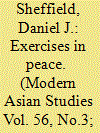

|
|
|
|
|
| Summary/Abstract |
In 1650, an encyclopedia of comparative religion known as Dabistān-i Maẕāhib (the School of Doctrines) was completed near the city of Hyderabad. Asserting that the religions of the world are reflections of a single inner truth, its author Mīrzā Ẕu'l-fiqār Āẕarsāsānī, known by the poetic penname ‘Mūbad’, travelled widely across India to record encounters with diverse religious figures. This article re-examines the composition and legacy of the Dabistān in light of new manuscript evidence relating to its author and the world he inhabited. It argues that the Dabistān's universalist project reflects a widely held theory of the interrelatedness of the macrocosm, in which sociality with diverse populations was understood to be a spiritual exercise leading to saintly perfection in the same way that venerating the cosmos and ascetic bodily practices were. The article provides a close reading of the Dabistān's shortest chapter on the religion of the Tibetans, the earliest such description in Persian. Situating the Dabistān within the diverse expressions of ‘Universal Peace’ (ṣulḥ-i kull) during the Safavid and Mughal periods, it argues that the Dabistān's project of recovering a universal theology that was attributed to ancient Iran and India led to expressions of dual religious belonging—to particular religions of revelation as well as to the universal religion of the philosophers—parallel to and connected with what Jan Assmann has termed the ‘religio duplex phenomenon’ in early modern Europe. Finally, the article briefly traces the legacy of the Dabistān into the modern period.
|
|
|
|
|
|
|
|
|
|
|
|
|
|
|
|
| 2 |
ID:
151803
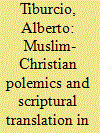

|
|
|
|
|
| Summary/Abstract |
This article explores the work of ʿAli-Qoli Jadid al-Eslām (d. circa 1722), a Portuguese Augustinian missionary who embraced Islam during in the late seventeenth century. This investigation situates the work of this author within the social, political, and intellectual context of the late Safavid period. It traces the genealogy of his work as a response to the Jesuit missionary Jerome Xavier (d. 1617) and the Italian scholar Filippo Guadagnoli (d. 1656). The article examines how ʿAli-Qoli’s production fits within the genre of dalā’il al-nubuwwah, whereby the Bible is used as “proof” of the validity of Islam. It also analyzes the author’s use of common tropes of polemical literature, mainly that of accusing Christian scholars of practicing taḥrīf or scriptural tampering.
|
|
|
|
|
|
|
|
|
|
|
|
|
|
|
|
| 3 |
ID:
177796
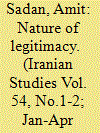

|
|
|
|
|
| Summary/Abstract |
This article examines history-writing in Safavid Iran and, in particular, the notable chronicle from the time of Shah ʿAbbas I, the Tārīkh-e ʿĀlam-ārā-ye ʿAbbāsī (TAAA). It rethinks Safavid history-writing via the perspective of environmental history. This article asks, “How was the natural world represented in the chronicle, and in what way did this representation shape the Safavid historical narrative?” It argues that the ways in which the TAAA portrays human encounters with nature suggest ʿAbbas’ unique sovereignty over it. Because of his piety and devotion, he was considered blessed with divine grace, making him the only human being with the ability to regulate natural manifestations—that is, to dominate, to manipulate, to survive, and to contain nature. Against a backdrop of an absence of environmental readings of Safavid history, the article suggests looking at the TAAA’s representation of this natural world as a powerful legitimizing force for ʿAbbas’ reign, as it is one that has not yet been foregrounded.
|
|
|
|
|
|
|
|
|
|
|
|
|
|
|
|
| 4 |
ID:
128569
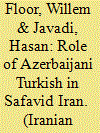

|
|
|
|
|
| Publication |
2013.
|
| Summary/Abstract |
Turkic languages and dialects played a much more important role in Safavid Iran than is generally thought, while Azerbaijani Turkish in particular was widely spoken and written in Safavid Iran. It was not only the language of the court and the army, but it was also used in poetry, even by renowned poets who usually wrote in Persian. The Safavid shahs, many of whom wrote poetry in Turkish themselves, promoted its literary use. Also, Turkish was used in the court's official correspondence, for both internal and external affairs.
|
|
|
|
|
|
|
|
|
|
|
|
|
|
|
|
| 5 |
ID:
168976
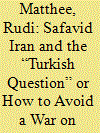

|
|
|
|
|
| Summary/Abstract |
This essay parts with the compartmentalized way in which scholarship tends to view Iran’s military predicament in the Safavid era by examining the perennial threat the Ottomans posed to the country largely in isolation from the recurring conflict between the Safavids and their other main adversaries, the Mughals and Uzbeks, respectively. The security dilemma facing Safavid Iran, it is argued here, was acute as well as multifaceted, and should be approached as such. All three of its direct neighbors were Sunni and two, the Ottomans and the Mughals, were capable of mobilizing far greater military resources than Iran. The main strategic concern of the Safavids was to prevent these neighbors from joining forces and engaging them in a two-front war. This study examines balancing the strategies employed by the three most consequential Safavid shahs, Esma‘il I (1501‒24), Tahmasb (1524‒76), and ‘Abbas I (1587‒1629), to avoid becoming the target of a simultaneous or combined assault by their neighbors. This analysis provides the backdrop to the rational decision the Safavids made in 1639—to end the threat of a two-front war by concluding a lasting peace accord with their most formidable enemies, the Ottomans.
|
|
|
|
|
|
|
|
|
|
|
|
|
|
|
|
|
|
|
|
|